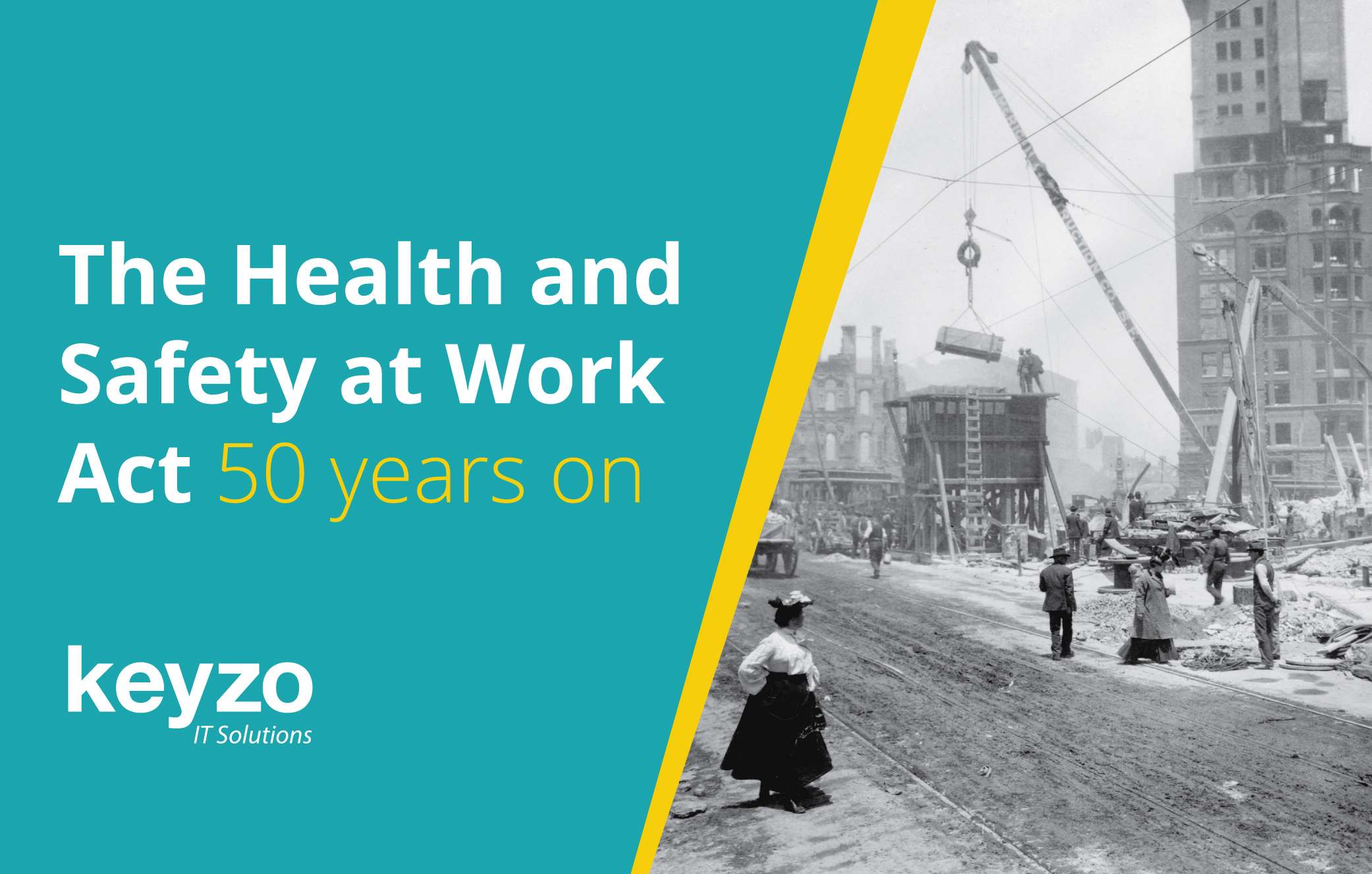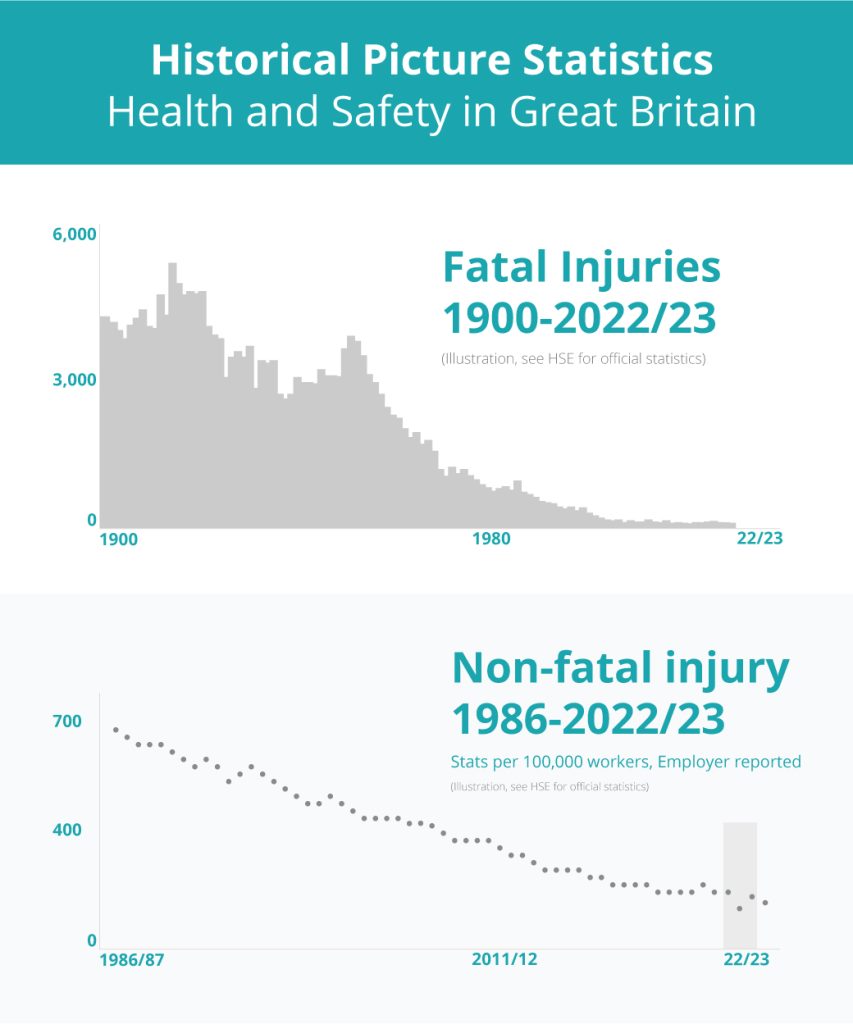
History of the Health and Safety at Work Act | 50 years on
This year marks a special milestone for the history of health and safety at work – the 50th anniversary of the Health and Safety at Work Act 1974.
It’s a time to pause and look back at how far we’ve come, thanks to this important law. For five decades, the Health and Safety at Work Act has ensured that every worker steps into a workplace that’s not just a job site, but a safe haven.
So, as we celebrate this milestone, it’s a perfect opportunity to delve into why this act matters, how it came to be, and the difference it’s made in countless lives.
Key Points:
In 1900 there were approximately 4,400 deaths a year. In 22/23 there were 135 fatalities, 91 employees and 44 self-employed (source).
Between 1970 and current day, fatal injuries have fallen by around 85% (source).
In 1974, the Health and Safety at Work Act became the bedrock of workplace safety regulations. Its purpose? Simple yet important: to keep workers safe and healthy.
Across industries, from construction sites to offices, this act set the standard for what it meant to prioritise the well-being of those who keep our world turning.
From the moment it came into effect, this act has guided employers and employees alike, reminding us that no job is worth risking a life or limb.
Before the Health and Safety at work act
Prior to the act, workplace safety relied on a patchwork of regulations with poor enforcement. This meant many industries lacked proper safety standards.
Though there aren’t any datasets on workplace injury and illness before 1974, well documented disasters like the Flixborough chemical plant explosion in 1974 woke people to the issue.
The tragedy claimed 28 lives, and though appearing as a single incident, had various contributing factors, all linked to health and safety. Safety culture was poor, production was pressured with demands, and plant equipment change lacked thorough risk assessments, failing to identify the potential for failures.
Back then, safety wasn’t a priority; it was an afterthought, if considered at all. The absence of comprehensive regulations meant that accidents were not just common; they were almost expected.
Key provisions of the Health and Safety at work act
Central to the Health and Safety at Work Act are provisions that place a legal duty on employers to ensure the health, safety, and welfare of their employees.
At the heart is a simple yet powerful principle: the safety and well-being of workers must come first. It’s not just a suggestion; it’s a requirement – a promise to prioritise the health, safety, and welfare of every employee.
Health and Safety at Work Act also lays out guidelines for employer duties, employee duties, duty to others and risk assessments. It instils a preventative approach to workplace safety and ensures that hazards are identified and mitigated before they become accidents waiting to happen.
It empowers workers to speak up about safety concerns without fear, creating a culture of open communication and collaboration. In essence, these provisions aren’t just rules written on paper; they’re promises made to workers.
Impact on workplace safety
Over the past five decades, the Health and Safety at Work Act has played a pivotal role in shaping workplace practices and standards. Not only did it change laws, it changed minds and ways of thinking about safety and accountability.
Employers began investing in safety measures, from training programs to protective equipment, knowing that keeping workers safe wasn’t just the right thing to do – it was the law.
Since its enactment year, the Health and Safety at Work Act has helped drastically improve workplace safety in the UK. And though other factors such as changing occupational structure, better reporting systems, and other health and safety measures play a role in statistics, the improvements are undeniable.

Charts are illustrations of data available in the HSE ‘Historical picture statistics in Great Britain, 2023’
Challenges and Criticisms
Despite its achievements, the Health and Safety at Work Act has faced challenges and criticisms over the years.
Regulatory Burden: There is a perceived regulatory burden placed on businesses, particularly small and medium-sizes businesses. It’s argued that compliance with the act can be costly and time-consuming, especially for smaller businesses with less resources.
Enforcement Issues: Despite clear legal duty placed on employers, sometimes the ways of enforcing it haven’t been strong enough. This means some employers might ignore the rules and get away with it. This weakens the whole law and leaves workers at risk.
Evolving Workplaces: Changing ways of working and new risks are an ongoing challenge for workplace safety regulations. As tech and new ways of working emerge, ensuring that the Health and Safety at Work Act is relevant and effective requires constant adaptation.
Mental Health: The Health and Safety at Work Act doesn’t explicitly address mental health risks, a problem that’s growing in todays working environment.
Evolving Safety Landscape & Tech
Technology has played a huge role in enhancing workplace safety and compliance, providing tools and insights to identify and mitigate risks.
If we imagine a timeline from 1974 – 2024, the availability and capability of tech has drastically changed.
Data and analytics wasn’t something that could be used effectively 50 years ago, but today there’s vast amounts of data available, whether that’s public data from bodies like the HSE about the UK workforce, or internal data from companies that have adopted different tech or software.
Software has arguably been one of the most impactful applications of technology as it allows businesses to deploy systems which best fit their business and track data relevant to them.

It has given businesses a means to tackle regulatory burden and enforcement issues, making it easier for them to apply and demonstrate compliance with regulation.
For example induction and training metrics for all people visiting company premises’, and undeniable evidence of employee acknowledgement and understanding of key policies and documents.
The potential for technology to enhance workplace safety is huge. Companies that embrace tech will be able to create safer, healthier work environments for their employees, reducing accidents, injuries and fatalities at work.
The future of Health and Safety at Work
The journey of workplace safety is far from over, the ways we work will continue to change, environments will shift, new risks will emerge, and regulatory frameworks will need to adapt.
The increase of remote work, the gig economy, mental health awareness and automation have begun to challenge traditional ideas of workplace safety in recent years. New risks are emerging, from cyber threats to ergonomic issues of computer use, but at the same time, regulatory bodies are updating and refining safety standards to keep pace with change.
However, one thing remains constant, something that the Health and Safety at Work Act introduced, the promise of safety to all workers and the ongoing vigilance for a safer and healthier workplace.
Praise and appreciation
As we celebrate 50 years of the Health and Safety at Work Act, it’s a moment to pause and reflect on the improvements made in workplace safety.
This piece of legislation changed the way we view safety at work, acting as the foundation on which safer workplaces have been built, lives saved, and injuries prevented across industries.
Today we take Health and Safety practise for granted, but we owe a debt to all those who have contributed to the success of The Health and Safety at Work Act, from law and policymakers to safety professionals and frontline workers.
As we reflect we must also look to the future with urgency and purpose to continue these great efforts. The work of creating safer workplaces is ongoing, but by contributing to our own safety and remaining committed, the impact can be enjoyed for years to come.
